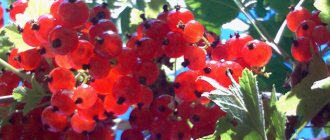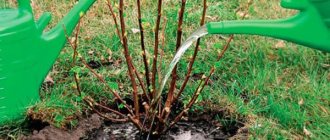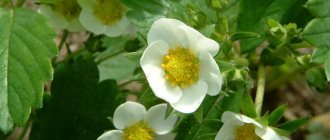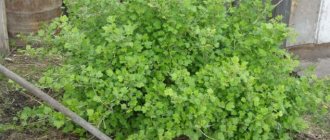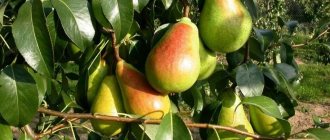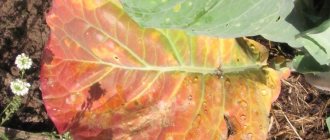When starting the business of a gardener or gardener, we all believe that our harvest will be large, in large quantities, juicy and tasty. After a certain period of time and having come to the moment of fruiting, sometimes you can be disappointed by not receiving the expected currants. This result can be very unexpected, because the bushes, in the absence of a harvest, are outwardly in excellent condition. So why don’t currants bear fruit?
There may be a lack of berries even if the bush has passed the flowering period. From time to time, currants produce purple inflorescences, but no berries are formed on them. In addition, the bush can produce buds, but of a distorted shape, outwardly similar to a head of cabbage and larger in comparison with the usual size.
Currants do not bear fruit for various, but very specific reasons. The main ones are: inconsistency in the weather conditions for growing the plant due to climatic conditions, improper care of the bush or its improper planting, diseases and pest infestation.
Let's take a closer look at these and other reasons in more detail.
Table of yield norms by variety and age of bush
If you have recently started growing currants on your site, and cannot determine by eye whether the harvest is good or not, the yield table below will come to your aid.
| Variety name | Age (years) | Ripening time | Productivity kg/bush |
| The Little Prince (black) | From 2 to 12 | Precocious | 5,5 |
| Lazy (black) | From 2 to 12 | Late | 2,5 |
| Exotic (black) | From 3 to 12 | Early | 4,5 |
| Natalie (red) | From 2 to 14 | Mid-season | 3,5 |
| Red Lake (red) | From 3 to 13 | Mid-season | 4 |
| Bayana (white) | From 2 to 12 | Late | 3,5 |
| Smolyaninovskaya (white) | From 3 to 14 | Mid-season | 4 |
Note! The yield of currants grown in greenhouse conditions, with proper care, differs from the yield of ground currants by 0.5-2.5 kilograms from the average.
Infectious background in the area
In addition, the reason for poor yields of currants and gooseberries may be a high infectious background in the area.
Gardeners often try to grow these plants without using chemical protection. Organic berries are, of course, good.
And in the first years of plant life, while they are strong, strong and not inhabited by harmful organisms, it is indeed possible to obtain a high yield without the use of pesticides.
But as the infectious background accumulates, the plant spends more and more energy on the struggle for survival, and not on growth and fruiting.
How to understand that there is a meager harvest of currants
You can determine the quality of the harvest collected from one bush by eye and weight. The first method is available only to experienced summer residents who have been growing this crop for several years. Anyone can use the second one. To do this you need:
- pick berries from one bush;
- weigh them;
- compare the result with the average indicators characteristic of representatives of this variety.
Typically, a result of 1-1.5 kilograms of berries collected from one bush is considered bad. If your indicators are close to this, it means you are not caring for the plant well.
What reasons lead to the absence of fruits?
There are many reasons why yields sharply decrease or disappear altogether. Here is a list of the main ones:
- climatic conditions are not suitable for this variety;
- bushes are planted in the wrong place;
- plantings are in the shade;
- incorrect soil composition;
- increased soil acidity;
- lack of water;
- the dose of fertilizer is calculated incorrectly;
- there are no natural pollinators in the area;
- the bush is too old and cannot bear fruit.
Each of these reasons can significantly reduce the quality of the crop and requires separate consideration.
Unsuitable climatic conditions
The first factor influencing the formation and growth of berries is the correct climate. The fact is that different varieties of currants have different preferences for climatic zones. Some show good results in warm regions, others like cool weather.
When buying currants for cultivation, pay attention to this factor, otherwise, instead of juicy, tasty berries, you will get ordinary barren flowers. Such a waste of money and time will not appeal to any summer resident.
Wrong place to grow shrubs
The landing site plays a huge role in the development and formation of this culture. The optimal ratio of light and shadow, humidity, soil quality - all these indicators, taken together, form the future harvest. Many novice gardeners mistakenly assume that since currants are an unpretentious plant, they do not need to take care of them, and they can be planted at random. The payback for such thoughts comes in the form of bare branches, instead of an abundance of berries on them.
See also
Description of currant variety Dar Smolyaninova, features of planting and careRead
Too shady area
Currants prefer a balance between sunlight and shade. An excess of one factor or another primarily affects their size and taste. Bushes growing on the sunny side produce sweet but small berries. Berries grown in shaded areas are larger, but when eaten, a bright sour note is felt. Excessive solar activity or dense shade at the planting site negatively affects the development of the bush itself.
Unsuitable soil condition
Correctly selected soil composition at the planting site is the key to the successful development of any garden crop. Currants are no exception, and each of its varieties is demanding on the soil. Dense soil that is not properly irrigated will cause a lack of ovaries, the appearance of which directly determines the volume of berries collected at the end of the season.
To avoid such a problem, the soil around the bush is periodically loosened and irrigated abundantly, preventing it from drying out.
Soil acidity
Before planting currant seedlings, highly acidic soil is treated with lime. This must be done at least 1 year before planting. If everything is done correctly, the acidity of the soil will reach its optimal level within a year. This factor should not be neglected, since in the future, because of it, all the work may go down the drain.
Moisture deficiency
Poor irrigation is equally destructive for all crops. If currant plantings experience moisture deficiency, this will result in:
- slowdown in growth rates;
- absence of ovaries on the branches;
- dying off of green mass;
- reduction in the number of fruits.
Don’t be lazy to water the ground around the bush if you haven’t done it for a long time. However, you should not give a lot of moisture either. Due to excessive amounts of water, the roots will begin to rot, which will lead to the death of the seedlings. Maintain balance.
Lack or excess of fertilizers
For some gardeners, shocking news is the information that excess fertilizer does not benefit the crop. Currants are one of those species that prefer rare but varied feedings. The reason that the currants have completely stopped bearing fruit may be:
- using the same type of fertilizer for an extended period of time;
- excess amount of mineral fertilizers in the soil;
- poor soil composition due to lack of fertilizing.
Lack of pollination and pollinators
Most varieties are self-pollinating crops that do not depend on external factors. However, there are also bushes that cannot pollinate on their own. If currants do not bloom, honey-bearing flowers are planted on the site. They serve as natural mediators in this process, helping in the pollination process.
Note! Experienced gardeners recommend planting currant bushes of the same type in one area, which begin to bloom at different times. This will increase the fruiting period and harvest volume.
Old age of the bush
The life cycle of a crop has its limitations, and the older the bush, the fewer berries it bears, since berries are not set on old branches. Scientists have derived the following dependence of the number of berries on the age of the bush:
- the first berries begin to form on bushes aged 2 to 4 years;
- then, within 4 years, black currants experience a peak in productivity. For white and red varieties, the peak age is 5-6 years;
- the next 5-6 years there is a decline.
See also
Description of black currant variety Sevchanka and characteristics, planting and careRead
The maximum age for fruiting for black currants is 12 years, for other varieties - 15 years. After this period, the old seedlings are removed and a new plantation is established.
Old age of plants
All plants have a certain life cycle. Currants are no exception. The peak yield of berry crops occurs at the age of 4-6 years. Then the intensity of fruiting declines. Not only the quantity of the crop decreases, but also its quality. If the bush is more than 10 years old, poor yield is a natural process. Such specimens should be removed and young plants planted.
Old unfruitful currant
Diseases and pests of currants that impair fruiting
Negative dynamics during harvest can be observed due to disease of the bush or pests parasitizing on it. These include:
- kidney mite;
- glass butterfly;
- forest ants;
- terry or reversion;
- invasion of common ants.
At the first signs of their appearance, it is necessary to take urgent measures, otherwise the bush will not produce a harvest or will die altogether.
Kidney mite
A parasite whose favorite delicacy is currant buds. The main sign of its appearance is considered to be the unnatural size of the kidneys. Such specimens should be plucked from the branch and burned. It is impossible to cure neglected bushes and, in order to avoid the spread of the parasite, they are dug up and then destroyed by fire. Garlic planted next to the plantation can provide protection against ticks.
glass butterfly
A dangerous parasite that is difficult to identify visually. The first signs of its appearance include:
- death of ovaries;
- leaves begin to fall from the branches.
The butterfly lives inside the shoots, making artificial tunnels there. The juice circulating inside the shoots serves as food for the glass. Affected parts must be cut off and destroyed as quickly as possible. If problems cannot be identified in time, the bush is pruned to the very root.
Forest ants
Forest ants eat the flowers of the plant, which is why it stops bearing fruit. Damaged flowers are discarded and do not participate in the pollination process. One colony can destroy several bushes, therefore, when it is detected, the anthill is destroyed. For this, proven folk remedies or special preparations sold in stores are used.
Reversion or terry
A viral disease, the carrier of which is considered to be the kidney mite. Signs of the disease:
- leaves become limp and thin;
- change in leaf color from green to dark green or purple. The surface of the leaf becomes covered with plaque;
- healthy leaves emit a pleasant aroma that is absent from the affected counterparts.
The disease spreads quickly, and to eliminate it the entire bush is burned at once.
Ant invasion
Ordinary ants, like their forest counterparts, pose a great threat to the plantation. If an anthill appears in the immediate vicinity of the landing zone, it should be destroyed. Otherwise, the flowers will be eaten and the berries will not be able to form.
Gardener mistakes that lead to currant infertility
Gardeners make mistakes when growing currants, which lead to the bushes stopping bearing fruit:
Mistakes
| What do they lead to? | |
| Plants are planted in an unsuitable place for its development. | The plant lags behind in development and its ability to bear fruit is reduced. |
| Currants are fed only with manure or other types of organic matter, without taking into account the needs of the crop and soil composition. | Excess nitrogen leads to hypertrophied growth of green mass and weakened fruiting. |
| They do not conduct regular inspections of bushes to detect signs of damage to currants by pests and diseases. | Pests that are not destroyed in time quickly spread and cause irreparable damage to currant plantings. |
You can prevent mistakes by studying the requirements of agricultural technology for growing currants and carefully observing all points.
In most garden plots, owners try to grow a variety of fruits and vegetables. Many people pay special attention to black currants. And not in vain, because such a bush has healthy, fortified and tasty berries.
Effective ways to increase productivity
To increase the number of berries formed on the branches, it is recommended:
- mulch the soil around the bushes, especially in autumn;
- the soil is periodically loosened, breaking up large lumps of earth;
- water the plantation as the soil dries out. Watering is especially important 2-3 weeks before and after picking berries;
- remove old, dry branches that stop growing;
- cross different varieties of currants, obtaining more stable combinations.
conclusions
- Currant fruiting is affected by weather conditions, the presence of pollination, soil moisture and light.
- The first active ripening of berries is observed 2-3 years after planting. The productivity of the bush decreases by 12-20 years, depending on the species.
- The formation of barren flowers or a decrease in yield can be caused by infection with diseases and pests.
- To increase productivity, proper care and cultivation techniques should be observed. Treat the planting in the spring against diseases and pests, and apply fertilizing in a timely manner.




